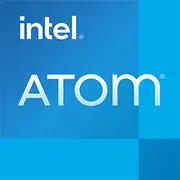Intel Atom E3845

Intel Atom E3845: A Modest Workhorse for Basic Tasks. An Analysis of Capabilities in 2025
In an era where Apple M3 and Intel Core Ultra processors vie for the title of the most powerful, and neural networks demand ever-increasing resources, modest chips like the Intel Atom E3845 seem archaic. However, even in 2025, such solutions find their niche. Let’s explore who might benefit from this processor today.
Architecture and Technology Process: Minimalism in Everything
Code Name and Technology:
The Intel Atom E3845, released back in 2013, belongs to the Bay Trail-I platform. It is manufactured using a 22-nm technology process, which appears outdated in 2025 compared to Apple’s 3-nm chips and AMD’s 5-nm solutions.
Cores and Threads:
This chip is equipped with 4 physical cores without Hyper-Threading support—each core handles only one thread. The base frequency is 1.91 GHz; there is no turbo mode. This fixed frequency limits adaptability under load.
Integrated Graphics:
The built-in GPU is Intel HD Graphics (Bay Trail) with 4 execution units (EU) and a frequency of up to 792 MHz. It supports DirectX 11 but is not designed for modern APIs like Vulkan or DirectX 12 Ultimate. The maximum resolution is 2560x1600, but for smooth operation, 1080p will suffice.
Architecture Features:
- No support for AVX instructions;
- L2 cache of only 2 MB (512 KB per cluster of two cores);
- Single-channel DDR3L-1333 memory—a narrow "bottleneck" for data.
Power Consumption and TDP: As Cold as Siberia
With a TDP of 10 W, the E3845 is one of the "coolest" x86 processors available. This allows it to be used in devices:
- Without active cooling—for example, in thin tablets or kiosks;
- With passive heatsinks—as in industrial computers;
- In compact IoT devices—sensors, POS terminals.
Even under full load, the chip does not heat above 60–65°C, which eliminates throttling in properly designed systems.
Performance: The Realities of 2025
Geekbench 6:
- Single-Core: 151 points (for comparison: Apple M1 — 2300);
- Multi-Core: 435 points (AMD Ryzen 3 7320U — 4800).
Real Tasks:
1. Office Work:
- LibreOffice Writer, Excel with spreadsheets up to 1000 rows—acceptable, but with lags on complex formulas;
- Simultaneously opening 5–7 tabs in Chrome (with heavy scripts disabled)—possible, but with "freezes."
2. Multimedia:
- 1080p@30fps (H.264) video—decoded in hardware, without lags;
- 4K video—not supported;
- Photo editing in GIMP—only basic adjustments (cropping, filters), but with noticeable response time.
3. Gaming:
- Minecraft (Low settings, 720p)—20–25 FPS;
- Stardew Valley, Terraria—stable 30 FPS;
- Modern games—will not run even at minimum settings.
Turbo Mode: Absent. The processor operates at a fixed frequency, simplifying thermal design but limiting peak performance.
Use Cases: Who is E3845 Suitable for in 2025?
1. Budget Laptops for Basic Tasks:
Devices priced at $150–$250 (for example, TrekStor Surfbook E13 or Chuwi LarkBox). Suitable for:
- Web surfing;
- Document work;
- Watching YouTube in HD.
2. Industrial and Embedded Systems:
- Information kiosks in museums;
- Food ordering terminals;
- Control modules for smart homes based on Linux.
3. Backup Devices:
A cheap laptop "just in case"—for trips, a country house, or as a temporary replacement for a broken main PC.
Autonomy: Up to Two Days Without a Socket
With a battery capacity of 42 Wh (typical for 11-inch laptops), the E3845 provides:
- 8–10 hours of web surfing (brightness at 50%);
- 12–14 hours of local video playback;
- Up to 20 hours in PDF reading mode.
Power Saving Technologies:
- Intel SpeedStep—dynamic frequency reduction during idle;
- C-states—shutting down unused cores;
- Support for S0ix (a modern equivalent of sleep mode).
Comparison with Competitors: Who Else is in the Same Class?
1. AMD A4-5000 (Kabini, 2013):
- 4 cores, TDP 15 W;
- Better graphics (Radeon HD 8330), but higher power consumption;
- Falls short in battery life.
2. Intel Celeron N4020 (Gemini Lake, 2019):
- 2 cores, 4 threads, TDP 6 W;
- Geekbench 6 Single-Core: 380 (+151% compared to E3845);
- Compatible with DDR4, HDMI 2.0.
3. Apple A10 Fusion (2016):
- Used in older iPads;
- Single-Core: 760 (5 times faster than E3845);
- However, the iOS ecosystem limits application.
Conclusion: E3845 lags behind even budget chips from 2019–2020 but has an advantage in the price of devices based on it.
Pros and Cons: When to Choose and When to Walk Away
Strengths:
- Price of laptops starting from $150;
- Passive cooling (silence);
- Compatibility with Windows 10/11 and Linux.
Weaknesses:
- Cannot handle Zoom + browser simultaneously;
- No support for Wi-Fi 6 or USB-C;
- RAM is usually limited to 4 GB (often non-removable).
Device Selection Recommendations
1. Type of Device:
- Ultra-budget laptops (TrekStor, Chuwi);
- Mini-PCs for digital signage;
- Tablets with keyboards (rare, but available).
2. Things to Look For:
- SSD is a must—even 64 GB eMMC is better than HDD;
- IPS display—TN panels degrade color reproduction;
- Ports—HDMI and USB 3.0 are desirable;
- Battery—at least 40 Wh.
Example of a Good Model:
Chuwi HeroBook Pro 2025—a 14-inch laptop with E3845, 8 GB RAM, 128 GB SSD, IPS display. Price—$199.
Final Conclusion: Who is E3845 Designed for in 2025?
This processor is a choice for:
- Parents looking for a first laptop for their child;
- Travelers valuing battery life;
- Businesses deploying a terminal park.
Key Benefits:
- Cost under $200;
- Operation without a fan;
- Sufficient for basic tasks.
However, those planning to work with graphics, stream, or use modern applications should consider at least the Intel N100 (2023) or AMD Mendocino. The E3845 is a relic of the past that has not yet become an antique, but it already requires a thoughtful choice.
Basic
CPU Specifications
Memory Specifications
GPU Specifications
Benchmarks
Compared to Other CPU
Share in social media
Or Link To Us
<a href="https://cputronic.com/en/cpu/intel-atom-e3845" target="_blank">Intel Atom E3845</a>